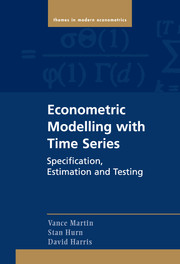Book contents
- Frontmatter
- Contents
- List of Illustrations
- Computer Code Used in the Examples
- Preface
- PART ONE Maximum Likelihood
- PART TWO Regression Models
- PART THREE Other Estimation Methods
- PART FOUR Stationary Time Series
- 13 Linear Time Series Models
- 14 Structural Vector Autoregressions
- 15 Latent Factor Models
- PART FIVE Nonstationary Time Series
- PART SIX Nonlinear Time Series
- Appendix A Change of Variable in Density Functions
- Appendix B The Lag Operator
- Appendix C FIML Estimation of a Structural Model
- Appendix D Additional Nonparametric Results
- References
- Author Index
- Subject Index
13 - Linear Time Series Models
from PART FOUR - Stationary Time Series
Published online by Cambridge University Press: 05 January 2013
- Frontmatter
- Contents
- List of Illustrations
- Computer Code Used in the Examples
- Preface
- PART ONE Maximum Likelihood
- PART TWO Regression Models
- PART THREE Other Estimation Methods
- PART FOUR Stationary Time Series
- 13 Linear Time Series Models
- 14 Structural Vector Autoregressions
- 15 Latent Factor Models
- PART FIVE Nonstationary Time Series
- PART SIX Nonlinear Time Series
- Appendix A Change of Variable in Density Functions
- Appendix B The Lag Operator
- Appendix C FIML Estimation of a Structural Model
- Appendix D Additional Nonparametric Results
- References
- Author Index
- Subject Index
Summary
The maximum likelihood framework presented in Part ONE is now applied to estimating and testing a general class of dynamic models known as stationary time series models. Both univariate and multivariate models are discussed. The dynamics enter the model in one of two ways. The first is through lags of the variables, referred to as the autoregressive part, and the second is through lags of the disturbance term, referred to as the moving average part. In the case where the dynamics of a single variable are being modelled, these models are referred to as autoregressive moving average (ARMA) models. In the multivariate case, where the dynamics of multiple variables are modelled, these models are referred to as vector autoregressive moving average (VARMA) models. Jointly, these models are called stationary time series models where stationarity refers to the types of dynamics allowed for. The case of nonstationary dynamics is discussed in Part FIVE.
The specification of dynamics through the inclusion of lagged variables and lagged disturbances is not new. It was discussed in Part TWO in the context of the linear regression model in Chapter 5 and more directly in Chapter 7 where autoregressive and moving-average dynamics were specified in the context of the autocorrelated regression model. In fact, a one-to-one relationship exists between the VARMA class of models investigated in this chapter and the structural class of regression models of Part TWO, where the VARMA model is interpreted as the reduced form of a structural model.
- Type
- Chapter
- Information
- Econometric Modelling with Time SeriesSpecification, Estimation and Testing, pp. 467 - 511Publisher: Cambridge University PressPrint publication year: 2012



